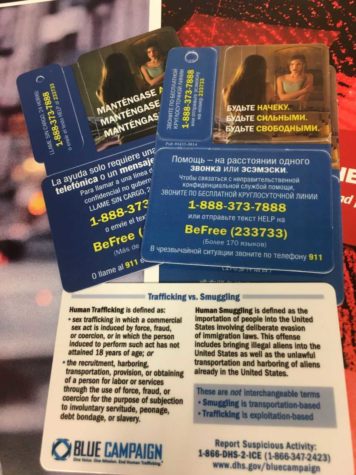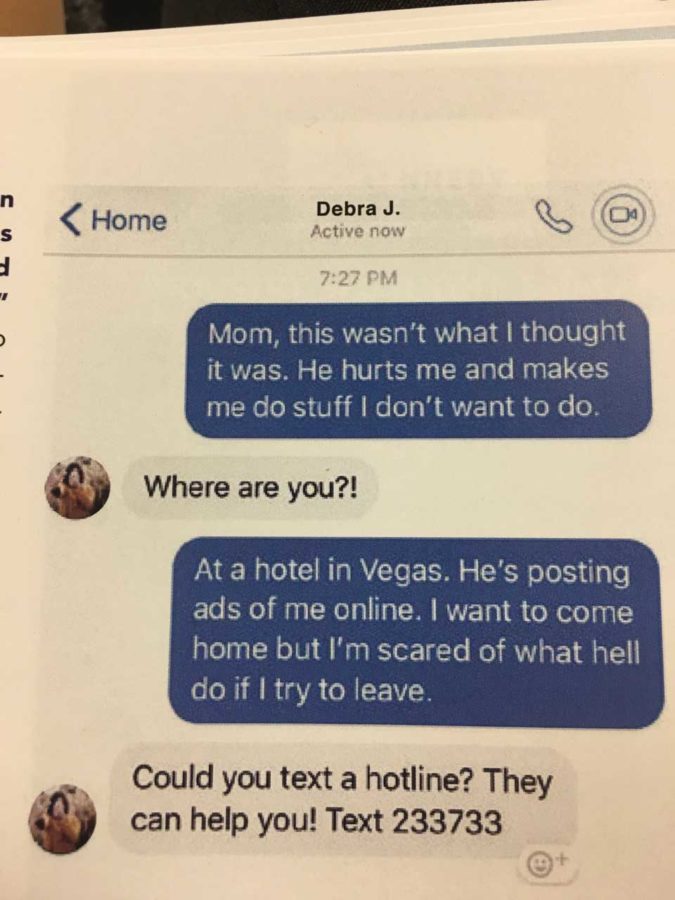Human Trafficking Introduction
The 3rd largest international crime industry is spreading to everybody’s backyard.
Through social media, a trafficked victim uses Facebook to message her mother and alert her of the situation. This screenshot is a real conversation posted for the public to see at Polarisproject.org
Las Vegas, Nevada is often thought of as the sex capital of the country. Prostitution is legal and permitted by state law in seven Nevada counties. Any county in Nevada with a population of 700,000 or less can license brothels and employ licensed prostitutes. In order to be a licensed prostitute, one must be at least 21 years old, except in Storey County where the minimum age is 18.
However, illegal prostitutes make 66 times more money for their pimps in comparison to regulated brothels. As a result, illegal prostitution and human trafficking is becoming a huge part of America’s illegal income. Recruiters are looking for girls as young as 12-14 years old. 70-90% of sex trafficking victims have been sexually abused prior to being trafficked.
There are numerous approaches pimps and would-be human dealers take within this dark industry. Each has a monicker which describes his particular MO, among which the following are included:
The “loverboy” is a category of trafficker who tends to prey on young girls in malls, group homes, and online in internet chat rooms, where kids in groups typically have little to no adult supervision. The traffickers then befriend the young girls, making them feel special to have somebody who cares and loves for them.
The “enabler” is the trafficker who offers young girls’ access to alcohol and drugs. The most vulnerable girls in this situation are addicts and runaways with no job or family. There are times when the pimp lures a girl in just by offering to take them to a party.
The “peer pressure” traffickers like to send out their top girl to recruit and trick other young women into sex trafficking. Approximately 70% of victims are recruited by someone they know.
The “Gorilla Pimp” is known as the most violent and cruel type of trafficker. These pimps intimidate and abuse young girls, ensuring they feel weak and inferior. Sometimes the trafficker tattoos their name on the girl to claim them as their own property. If a girl does not meet her nightly quota, the pimp will inflict painful punishments and make sure the girl feels humiliated.

The human trafficking industry is a threat to all people, not just Americans or English speaking people. This problem is worldwide and continues to be, which is why these information cards are distributed by the Department of Homeland Security.
These are only a few of the different types of sex traffickers that lure young girls in every day, right under our noses. With advancements in technology, sex trafficking will only continue to grow and become more complicated to prevent. According to the International Labor Organization, forced labor and human trafficking is a $150 billion industry worldwide. There are an estimated 40.3 million victims of human trafficking around the world. 75% of these 40.3 million victims are women and girls, 25% are children. 81% of these women and children are trapped in forced labor.
The National Human Trafficking Hotline and Polaris BeFree Textline states that more than 49,000 cases of human trafficking have been reported in the last ten years. Every year the hotline receives multiple reports of human trafficking cases in each of the 50 states and Washington D.C. An average of 150 calls are made to the human trafficking hotline every day. The National Human Trafficking Hotline website posts real stories and experiences of victims who call to escape their horrific situations.
In December 2015, a story was published on the website about a Laura, a middle school counselor showing concern over the possibility of one of her students being engaged in commercial sex. Alyssa, the student in question, lived in a foster home and was a frequent runaway. Her peers believed she was having sex in exchange for money and her foster parent started to take notice of many nice and expensive gifts. She was found at a house with several adults where commercial sex was believed to be taking place. The National Hotline assisted Laura with information to refer her to local resources and a comprehensive assessment tool to share with her colleagues and other educators. Alyssa was able to escape from her situation, thanks to the help of Laura and the National Hotline.

Human trafficking is growing to be a huge international illegal business. The people lured into the business are treated and sometimes labeled as sex slaves. With a whopping estimate of 20 to 30 million slaves in the world, the problem only seems to worsen. The United States State Department reports that 600,000 to 800,000 people are trafficked across international borders every year. Illegal drugs and arms trafficking are the top two largest international crime industries with human trafficking being just behind them.
Locally, Newport News, Norfolk, Portsmouth, and Virginia Beach are convenient locations for trafficking to take place. With proximity to ports and access to the interstate, Hampton Roads is a hub for the human trafficking business. Unfortunately, most people do not realize that the issue is a real one and is occurring all over the country.
The advancement of technology will make law enforcement’s job harder; however, if people continue to come together, this problem can be conquered and prevented.




